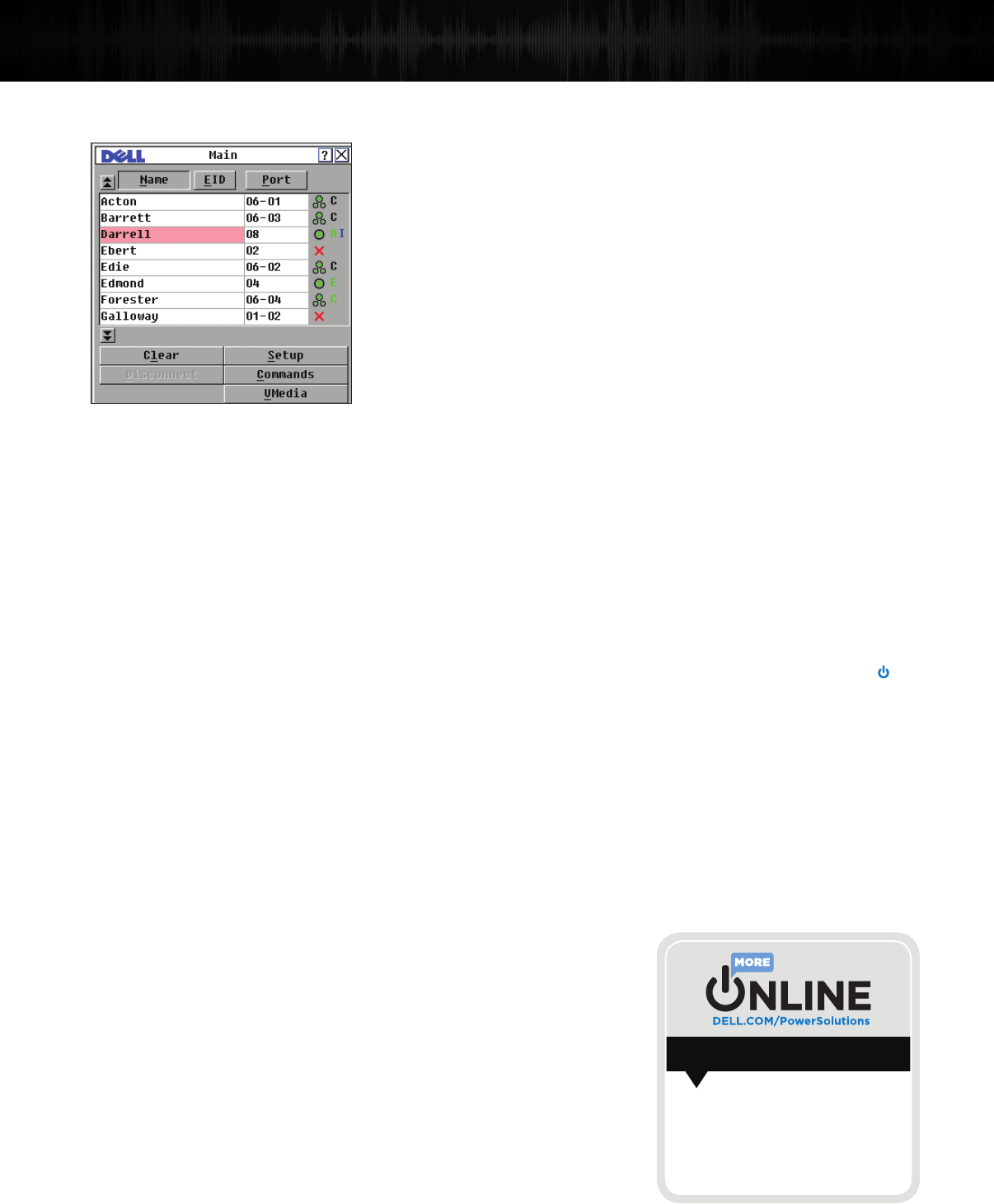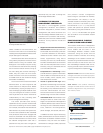
61DELL.COM/PowerSolutions
Reprinted from
Dell Power Solutions,
February 2008. Copyright © 2008 Dell Inc. All rights reserved.
select a blade to view and control, the
Avocent iKVM switch can automatically
reconfigure the keyboard and mouse to the
proper settings for that blade.
Administrators also have the option of
using hotkey sequences to access server
blades without using the OSCAR main
dialog box. For example, they can config-
ure the switch so that rather than pressing
the Print Screen button twice to bring up
the main dialog box and then selecting a
blade, they can press the Print Screen
button and then the first few characters
of a blade name or slot number to display
that blade immediately.
The Avocent iKVM switch also enables
administrators to send keyboard and
mouse actions to multiple server blades
simultaneously, helping simplify the pro-
cess of managing multiple blades at once.
They can configure the switch to broad-
cast keystrokes and mouse movements
independently as well, providing addi-
tional management flexibility.
The switch provides basic security
capabilities to help prevent unauthorized
users from controlling the server blades.
For example, the OSCAR interface allows
administrators to protect the system with
a screen saver password: after a defined
time period, the screen saver engages and
access is prohibited until the password is
entered. Administrators can also protect
the OSCAR configuration itself with a
password. If they ever lose or forget this
password, they can clear it through the
PowerEdge M1000e CMC.
ACCESSING THE CHASSIS
MANAGEMENT CONTROLLER
The CMC is a hot-pluggable systems
management hardware and software
controller designed to provide remote
management and power control for the
Dell PowerEdge M1000e blade server. It
includes its own processor and memory,
and draws power from the modular blade
enclosure. Its key features include the
following:
Support for Microsoft Active Directory
■■
authentication: Directory services such
as Microsoft Active Directory maintain
a common database of information
needed to control network users and
assets; organizations using Active
Directory can use it to provide access
to CMCs. Administrators can centralize
CMC user IDs and passwords in Active
Directory using the standard schema
or an extended schema.
Comprehensive monitoring:
■■
CMCs
provide access to system information
and the status of components such as
server blades, power supplies, fans,
and temperature sensors.
Access to system event logs:
■■
CMCs
generate a hardware log of events that
occur on the chassis, which includes
the severity, time, and a description of
the event. Administrators can view,
save a text file version of, and clear the
hardware log from the CMC interface.
Automated alerts:
■■
Administrators can
configure CMCs to send e-mail mes-
sages or Simple Network Management
Protocol (SNMP) traps to alert them of
warnings or errors related to tempera-
tures, hardware mis-configurations,
power outages, fan speeds, and so on.
In addition to other ways of accessing
CMCs, administrators can use the Avocent
iKVM switch to establish racadm console
connections. They can then use racadm
commands to configure CMC properties
and perform remote management
tasks through a command-line interface.
Administrators can display a list of
available racadm commands, syntax infor-
mation, and other instructions by using
the command
racadm help. They can list
syntax and options for specific racadm
commands by using the command
racadm
help command. The Dell CMC user guide
also provides a list of available racadm
commands.
PROVIDING SIMPLE, FLEXIBLE
BLADE SERVER MANAGEMENT
The Avocent iKVM switch is designed to
provide easy access to each of the 16
server blades and the CMC in Dell
PowerEdge M1000e modular blade
enclosures. Using the switch with the
Avocent OSCAR interface and taking
advantage of the racadm console con-
nections can give administrators compre-
hensive access to and control over the
Dell PowerEdge M1000e blade server,
helping provide simple, flexible monitor-
ing and management capabilities.
Stephen M. Hahn has been the Dell account
manager at Avocent for the last eight years.
He has a bachelor’s degree from Boise State
University.
Chad Fenner is the product marketing
manager for blade servers at Dell. He has a
bachelor’s degree from Trinity University in
San Antonio, Texas.
Figure 1. Avocent OSCAR main dialog box for the Dell
PowerEdge M1000e blade server
QUICK LINKS
Avocent iKVM switch:
www.avocent.com
Dell PowerEdge M1000e:
DELL.COM/Servers




